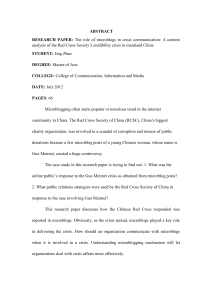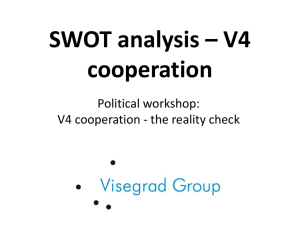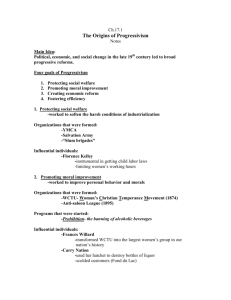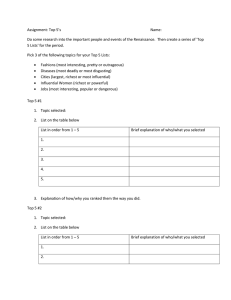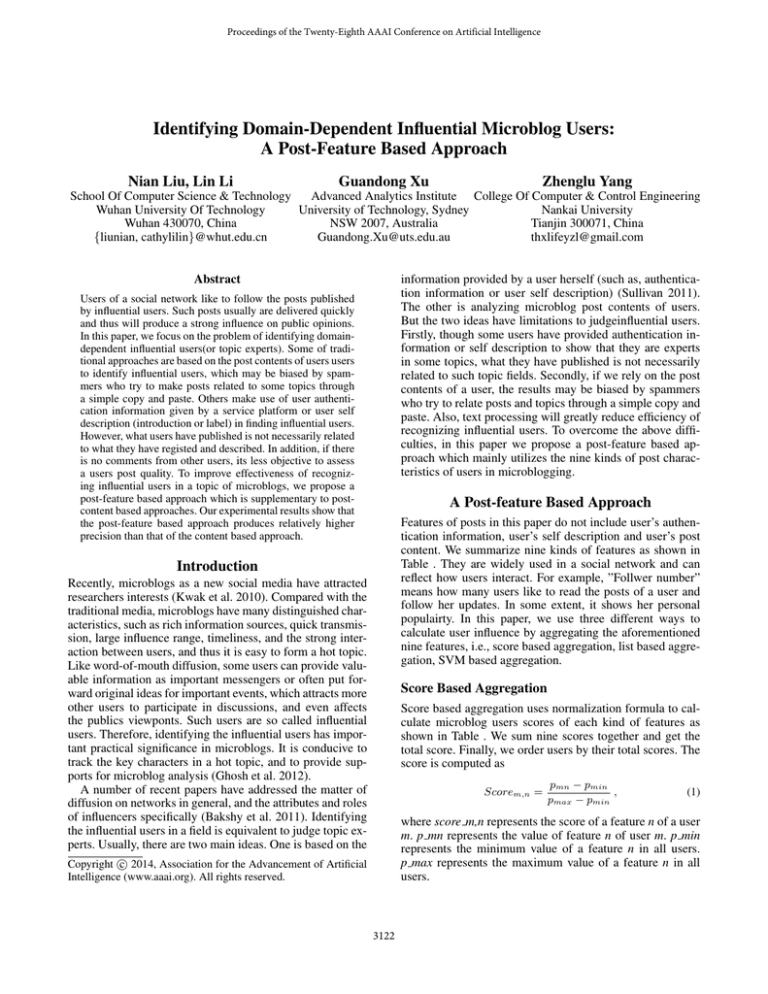
Proceedings of the Twenty-Eighth AAAI Conference on Artificial Intelligence
Identifying Domain-Dependent Influential Microblog Users:
A Post-Feature Based Approach
Nian Liu, Lin Li
Guandong Xu
Zhenglu Yang
Advanced Analytics Institute College Of Computer & Control Engineering
School Of Computer Science & Technology
Nankai University
University of Technology, Sydney
Wuhan University Of Technology
Tianjin 300071, China
NSW 2007, Australia
Wuhan 430070, China
thxlifeyzl@gmail.com
Guandong.Xu@uts.edu.au
{liunian, cathylilin}@whut.edu.cn
Abstract
information provided by a user herself (such as, authentication information or user self description) (Sullivan 2011).
The other is analyzing microblog post contents of users.
But the two ideas have limitations to judgeinfluential users.
Firstly, though some users have provided authentication information or self description to show that they are experts
in some topics, what they have published is not necessarily
related to such topic fields. Secondly, if we rely on the post
contents of a user, the results may be biased by spammers
who try to relate posts and topics through a simple copy and
paste. Also, text processing will greatly reduce efficiency of
recognizing influential users. To overcome the above difficulties, in this paper we propose a post-feature based approach which mainly utilizes the nine kinds of post characteristics of users in microblogging.
Users of a social network like to follow the posts published
by influential users. Such posts usually are delivered quickly
and thus will produce a strong influence on public opinions.
In this paper, we focus on the problem of identifying domaindependent influential users(or topic experts). Some of traditional approaches are based on the post contents of users users
to identify influential users, which may be biased by spammers who try to make posts related to some topics through
a simple copy and paste. Others make use of user authentication information given by a service platform or user self
description (introduction or label) in finding influential users.
However, what users have published is not necessarily related
to what they have registed and described. In addition, if there
is no comments from other users, its less objective to assess
a users post quality. To improve effectiveness of recognizing influential users in a topic of microblogs, we propose a
post-feature based approach which is supplementary to postcontent based approaches. Our experimental results show that
the post-feature based approach produces relatively higher
precision than that of the content based approach.
A Post-feature Based Approach
Features of posts in this paper do not include user’s authentication information, user’s self description and user’s post
content. We summarize nine kinds of features as shown in
Table . They are widely used in a social network and can
reflect how users interact. For example, ”Follwer number”
means how many users like to read the posts of a user and
follow her updates. In some extent, it shows her personal
populairty. In this paper, we use three different ways to
calculate user influence by aggregating the aforementioned
nine features, i.e., score based aggregation, list based aggregation, SVM based aggregation.
Introduction
Recently, microblogs as a new social media have attracted
researchers interests (Kwak et al. 2010). Compared with the
traditional media, microblogs have many distinguished characteristics, such as rich information sources, quick transmission, large influence range, timeliness, and the strong interaction between users, and thus it is easy to form a hot topic.
Like word-of-mouth diffusion, some users can provide valuable information as important messengers or often put forward original ideas for important events, which attracts more
other users to participate in discussions, and even affects
the publics viewponts. Such users are so called influential
users. Therefore, identifying the influential users has important practical significance in microblogs. It is conducive to
track the key characters in a hot topic, and to provide supports for microblog analysis (Ghosh et al. 2012).
A number of recent papers have addressed the matter of
diffusion on networks in general, and the attributes and roles
of influencers specifically (Bakshy et al. 2011). Identifying
the influential users in a field is equivalent to judge topic experts. Usually, there are two main ideas. One is based on the
Score Based Aggregation
Score based aggregation uses normalization formula to calculate microblog users scores of each kind of features as
shown in Table . We sum nine scores together and get the
total score. Finally, we order users by their total scores. The
score is computed as
Scorem,n =
pmn − pmin
,
pmax − pmin
(1)
where score m,n represents the score of a feature n of a user
m. p mn represents the value of feature n of user m. p min
represents the minimum value of a feature n in all users.
p max represents the maximum value of a feature n in all
users.
c 2014, Association for the Advancement of Artificial
Copyright Intelligence (www.aaai.org). All rights reserved.
3122
1
2
3
4
Feature
Follower number
Attention number
Mutual
follower
number
Post number
5
Average agreement
number
6
Average
number
7
Average comment
number
8
Forwarded
number
9
Total
microblog
number
retweet
post
Feature Description
The follower number of a user
The attention number of a user
The number of users to follow
each other
The number of microblog posts
that user have originally published over a period of time
The average agreement number
of user microblog posts over a
period of time
The average retweet number of
user microblog posts over a period of time
The average comment number
of user microblog posts over a
period of time
The forwarded number of microblog posts that user have
published over a period of time
The total number of microblog
posts that user have published
over a period of time
Method
hit ration
Score
35/90
List
43/90
SVM
46/90/
Baseline
35/90
Table 2: Our Experimental Results
students in our team are asked to judge whether a microblog
user is influential or not in IT field from their viewpoints. For
evaluation, we define a measure called hit ratio which counts
how many users are correctly identified. If our post-feature
based apporach says YES to an influential user, one is added
to hit ratio; if our approach says NO to a user which is not influential, one is also added to hit ration. By comparing three
kinds of post-feature based approachs with the baseline, our
results show that the post-feature based approach has higher
precision of identifying influential users than our baseline,
as shown in Table . The experimental results show that we
can identify users independent of microblog content by using content irrelevant features.
Conclusions
In this paper, we show that an effective solution to find influential users on microblog platform. We summarize the
post features of user features and design three approach to
judge domain-dependent influential users. The experimental
results show that our proposed approach has higher precision
than a post content based approach. In the future, we will
consider to combine post-feature and post-content to identify influential users through feature selection. More on our
research are on https://sites.google.com/site/gdxuau/.
Table 1: List of microblog user features
List Based Aggregation
According to the values of nine kinds of features, we can respectively get nine ranking lists of all users. Then we adopt
sorting fusion method(e.g., Borda Count (Borda 1781)) to
get total ranking list of all users. The borda count is a singlewinner election method in which voters rank candidates in
order of preference. It determines the winner of an election
by giving each candidate a certain number of points corresponding to the position in which he or she is ranked by each
voter. Once all votes have been counted the candidate with
the most points is the winner. We sum nine ranking lists together and get the total ranking list of all users.
Acknowledgments
This research was undertaken as part of Project 61003130
funded by National Natural Science Foundation of China.
References
Bakshy, E.; Hofman, J. M.; Mason, W. A.; and Watts, D. J.
2011. Everyone’s an influencer: Quantifying influence on
twitter. In Proceedings of the Fourth ACM International
Conference on Web Search and Data Mining, WSDM ’11,
65–74. New York, NY, USA: ACM.
Borda, J. 1781. Mmoire sur les lections au scrutin. Comptes
rendus de lAcadmie des sciences 44.
Ghosh, S.; Sharma, N.; Benevenuto, F.; Ganguly, N.; and
Gummadi, K. 2012. Cognos: Crowdsourcing search for
topic experts in microblogs. In Proceedings of the 35th International ACM SIGIR Conference on Research and Development in Information Retrieval, SIGIR ’12, 575–590. New
York, NY, USA: ACM.
Kwak, H.; Lee, C.; Park, H.; and Moon, S. 2010. What is
twitter, a social network or a news media? In Proceedings
of the 19th International Conference on World Wide Web,
WWW ’10, 591–600. New York, NY, USA: ACM.
Sullivan, D. 2011. Twitter improves who to follow results
& gains advanced search page.
SVM Based Aggregation
By using SVM, we randomly devide our whole data set into
training set (60%) and testing set(40%). Some students in
our team manually give their answer in judgeing whether a
user is influential or not in a topic. For cross validation, SVM
is run three times.
Experiments
Dataset
We extract dataset from sina microblog (weibo.com). It contains 90 users in IT field from October 19, 2013 to November
18, 2013. The dataset is composed of three types: 30 users
with service platform authentication information, 30 users
with self description of IT related words, 30 users without
any identifiers.
Experimental Results And Discussions
We compare our post-feature based approach with a baseline
which identifies influential microblog users by service platform authentication information or user self description. The
3123

